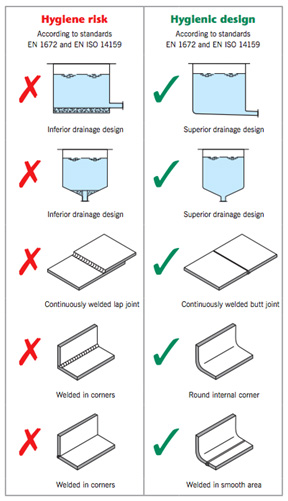Guidance
Hygiene
In order to maintain a clean and hygienic environment, it is essential that drainage elements are designed and manufactured to minimise bacteria traps.
ACO Food is designed for optimum hygiene performance, taking into account guidelines described in EN 1672, EN ISO 14159 and the European Hygienic Engineering and Design Group (EHEDG).
EN 1672 and EN ISO 14159 are standards that set out hygiene requirements for use in food processing.
EHEDG is a consortium of food industries, public health authorities, research institutes and equipment manufacturers. Their mission is to promote hygiene through improved hygienic engineering and design relating to all aspects of food manufacture. EHEDG principles are being recognised by designers and planners worldwide, including Australia.
Slip resistance
Slip resistant grates are recommended for installation in commercial kitchen and food processing area’s to reduce the risk of serious injury were high temperature food and equipment is used.
Stainless steel and nitrile rubber are easy to clean. Washing with soap or a mild detergent and warm water, followed by a clean water rinse is usually adequate for most industrial applications. An enhanced aesthetic appearance will be achieved if the cleaned surface is finally wiped dry.
Acids should only be used for on-site cleaning when all other methods have been proved unsatisfactory. Rubber gloves should be used and care taken to ensure acid cleaners are not spilt over adjacent areas.
Special precautions are necessary with oxalic acid and solvents should not be used in closed spaces without adequate ventilation. Manufacturer’s directions should always be followed.
If the suggestions in the table below have been attempted and the result is still unsatisfactory, stainless steel is able to be mechanically cleaned by specialists on site. Please contact ACO for further information.
| Problem | Cleaning agent | Comment |
|---|---|---|
| Routine cleaning, all finishes. | Soap or mild detergent and water (such as dishwashing liquid). | Sponge, rinse with clean water, wipe dry if necessary. |
| Fingerprints, all finishes. | Soap or warm water or organic solvent (e.g. acetone, alcohol). | Rinse with clean water, wipe dry if necessary. |
| Stubborn stains and discolouration. | Mild cleaning solutions or cream cleanser. | Rinse well with clean water and wipe dry. |
| Oil and grease marks, all finishes. | Organic solvents (e.g. acetone, alcohol). | Clean after soap and water, rinse with cleanwater and dry. |
| Rust and other corrosion products. | Oxalic acid. | Rinse well with clean water. The cleaning solution should be applied with a swab and allowed to stand for 15–20 minutes before being washed away with water. Use a mild cleaning solution to give a final clean if required. |
| Scratches on brush (satin) finish. | Household synthetic fibre scouring pads. | Do not use ordinary steel wool, as particles can become embedded in stainless steel and cause surface problems. For deeper scratches; apply scourer in direction of polising. Clean with soap or detergent as per routine cleaning. |
 Inspection and rodding
Inspection and rodding
A rodding eye is an access point in a drainage system that is used to inspect and rod blocked drainage pipes.
This is useful when pipes are located in areas where usual inspection and rodding are not possible, for example with a fixed (secondary) strainer.
| Pipe DN/OD (mm) | Weight (kg) | Stainless steel grade | Part No. |
|---|---|---|---|
| 100/110 | 1.5 | 316 | 416998 |
The corrosion resistance information contained within this table is indicative only.
All data is based on reactions noted at an ambient temperature of 20°C. Higher temperatures will generally reduce the corrosion resistance of the materials.
Typical factors that affect material selection:
- type(s) of chemical(s) and % composition in the liquid
- concentration percentages
- contact time with trough system
- temperatures of liquid flowing into the trough
- flushing system employed o clear liquids from the system
- type of cleaning agent (see Care & Maintenance)
- grate, locking mechnism and trash basket materials
- sealant for compatibility, if applicable
Test samples should be used for final determination of chemical resistance, contact ACO.
| Recommended | |
| Suitable, contact ACO for further advice | |
| Not recommended | |
| No data available |
| Reagent | Stainless Steel 304 | Stainless Steel 316 |
|---|---|---|
| Acetic Acid 20% | ||
| Acetic Acid 80% | ||
| Acetone | ||
| Alcohol (Methyl or Ethyl) | ||
| Aluminium Chloride | ||
| Aluminium Sulphate | ||
| Ammonia Gas (Dry) | ||
| Ammonium Chloride | ||
| Ammonium Hydroxide | ||
| Ammonium Nitrate | ||
| Ammonium Phosphate | ||
| Ammonium Sulphate | ||
| Ammonium Sulphide | ||
| Amyl Chloride | ||
| Aniline | ||
| Barium Chloride | ||
| Barium Hydroxide 10% | ||
| Barium Sulphate | ||
| Barium Sulphide | ||
| Beer | ||
| Beet Sugar Liquors | ||
| Benzene | ||
| Benzoic Acid | ||
| Bleach -12.5%Active C1 | ||
| Boric Acid | ||
| Bromic Acid | ||
| Bromine Water | ||
| Butane | ||
| Calcium Carbonate | ||
| Calcium Chloride | ||
| Calcium Hydroxide | ||
| Calcium Hypochlorite | ||
| Calcium Sulphate | ||
| Cane Sugar Liquors | ||
| Carbon Acid | ||
| Carbon Bisulphide | ||
| Carbon Dioxide | ||
| Carbon Monoxide | ||
| Carbon Tetrachloride | ||
| Caustic Potash | ||
| Caustic Soda | ||
| Chloride (Dry) | ||
| Chloride (Wet) | ||
| Chloroacetic Acid | ||
| Chlorobenzene | ||
| Chloroform | ||
| Chrome Acid 50% | ||
| Chromic Acid 10% | ||
| Citric Acid | ||
| Copper Chloride | ||
| Copper Cyanide | ||
| Copper Nitrate | ||
| Copper Sulphate | ||
| Cottonseed Oil | ||
| Cresol | ||
| Cyclohexanone | ||
| Cyclorexanol | ||
| Dimethyleanine | ||
| Dionylphalate | ||
| Disodium Phosphate | ||
| Distilled Water | ||
| Ethyl Acetate | ||
| Ethylene Chloride | ||
| Ethylene Glycol | ||
| Ethylene Glycol | ||
| Ferric Sulphate | ||
| Fluorene Gas (Wet) | ||
| Formaldehyde (37%) | ||
| Formic Acid (90%) | ||
| Freon 12 | ||
| Fruit Juices and Pulp | ||
| Furfural | ||
| Gasoline (Refined) | ||
| Glucose | ||
| Glycerine | ||
| Hydrobromic Acid (20%) | ||
| Hydrochloric Acid (40%) | ||
| Hydrocyanic Acid | ||
| Hydrogen Peroxide (90%) | ||
| Hydroquinone | ||
| Hypochlorous Acid | ||
| Iodine | ||
| Kerosene | ||
| Lactic Acid 25% | ||
| Linseed Oil | ||
| Liqueurs | ||
| Magnesium Chloride | ||
| Magnesium Sulphate | ||
| Maleic Acid | ||
| Methyl Chloride | ||
| Methyl Ethyl Ketone | ||
| Milk | ||
| Minerals Oils | ||
| Muriatic Acid | ||
| Nickel Chloride | ||
| Nickel Sulphate | ||
| Oils and Fats | ||
| Oleic Acid | ||
| Oleum | ||
| Oxalic Acid | ||
| Palmitic Acid 10% | ||
| Perchloric Acid 10% | ||
| Perchloric Acid 70% | ||
| Petroleum Oils (Sour) | ||
| Phenol 5% | ||
| Phosphorous Trichloride | ||
| Photographic Solutions | ||
| Picric Acid | ||
| Plating Solutions | ||
| Potassium Carbonate | ||
| Potassium Chloride | ||
| Potassium Cyanide | ||
| Potassium Dichromate | ||
| Potassium Hydroxide | ||
| Potassium Permanganate | ||
| Potassium Sulphate | ||
| Propane Gas | ||
| Propyl Alcohol | ||
| Sea Water | ||
| Sewage | ||
| Silver Nitrate | ||
| Silver Sulphate | ||
| Sodium Bicarbonate | ||
| Sodium Bisulphite | ||
| Sodium Carbonate | ||
| Sodium Cyanide | ||
| Sodium Ferrocyanide | ||
| Sodium Hydroxide | ||
| Sodium Hypochlorite | ||
| Sodium Sulphate | ||
| Sodium Sulphide | ||
| Sodium Sulphite | ||
| Sodium Thiosulphate | ||
| Stannous Chloride | ||
| Stearic Acid | ||
| Sulphite Liquor | ||
| Sulphurous Acid | ||
| Sulphur | ||
| Sulphur Dioxide (Dry) | ||
| Sulphur Dioxide (Wet) | ||
| Sulphuric Acid 50% | ||
| Sulphuric Acid 70% | ||
| Sulphuric Acid 93% | ||
| Tannic Acid | ||
| Tanning Liquors | ||
| Tartaric Acid | ||
| Toluene | ||
| Trichloroethylene | ||
| Triethanolamine | ||
| Trisodium Phosphate | ||
| Turpentine | ||
| Urea | ||
| Urine | ||
| Vinegar | ||
| Water (Fresh) | ||
| Water (Mine) | ||
| Water (Salt) | ||
| Whisky | ||
| Wines | ||
| Xylene | ||
| Zinc Chloride | ||
| Zinc Sulphate |







